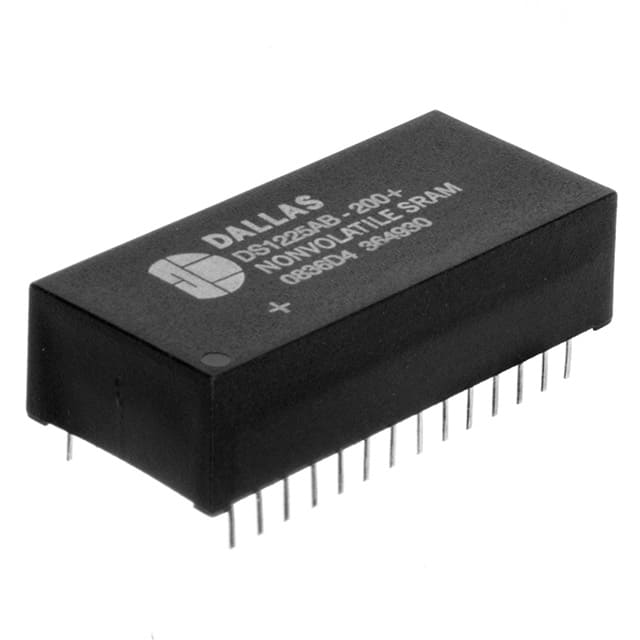Lihat spesifikasi untuk detail produk.

DS1230AB-70IND
Product Overview
Category
The DS1230AB-70IND belongs to the category of non-volatile static RAM (NVSRAM).
Use
It is primarily used for storing data in applications that require both high-speed read/write operations and non-volatility.
Characteristics
- Non-volatile: The DS1230AB-70IND retains data even when power is removed.
- High-speed operation: It offers fast access times for read and write operations.
- Low power consumption: The device operates at low power levels, making it suitable for battery-powered applications.
- Durable: With a minimum endurance of 10^14 write cycles, it ensures long-term reliability.
- Wide temperature range: The DS1230AB-70IND can operate in a wide temperature range, making it suitable for various environments.
Package
The DS1230AB-70IND is available in a 24-pin dual-in-line package (DIP), which provides easy integration into existing circuit designs.
Essence
The essence of the DS1230AB-70IND lies in its ability to combine the benefits of both RAM and non-volatile memory, providing a reliable and high-performance storage solution.
Packaging/Quantity
The DS1230AB-70IND is typically packaged in tubes or trays, with a quantity of 25 units per tube/tray.
Specifications
- Operating voltage: 4.5V to 5.5V
- Access time: 70ns
- Memory capacity: 256 kilobits (32 kilobytes)
- Data retention: Minimum 10 years
- Write endurance: Minimum 10^14 cycles
- Standby current: Maximum 100μA
- Operating temperature range: -40°C to +85°C
Detailed Pin Configuration
The DS1230AB-70IND has a total of 24 pins, each serving a specific function. The pin configuration is as follows:
- Chip Enable (CE)
- Output Enable (OE)
- Write Enable (WE)
- Address Inputs (A0-A14)
- Data Inputs/Outputs (DQ0-DQ7)
- Ground (GND)
- VCC
Functional Features
- High-speed read and write operations
- Non-volatile data storage
- Easy integration into existing circuit designs
- Low power consumption
- Durable and reliable performance
- Wide temperature range operation
Advantages and Disadvantages
Advantages
- Combines the benefits of RAM and non-volatile memory
- Fast access times for read and write operations
- Long-term data retention even without power
- Suitable for battery-powered applications
- Can withstand harsh environmental conditions
Disadvantages
- Relatively small memory capacity compared to other storage solutions
- Higher cost compared to traditional RAM
Working Principles
The DS1230AB-70IND utilizes a combination of volatile and non-volatile memory technologies. It employs a static RAM array for high-speed read/write operations and a non-volatile EEPROM array for data retention when power is removed. This hybrid design allows for fast and reliable data storage.
Detailed Application Field Plans
The DS1230AB-70IND finds applications in various fields, including: 1. Industrial automation systems 2. Automotive electronics 3. Medical equipment 4. Aerospace and defense systems 5. Communication devices 6. Power grid monitoring systems
Detailed and Complete Alternative Models
- DS1230Y-70IND: Similar specifications with a different package type (SOIC).
- DS1230AB-120IND: Higher access time (120ns) but larger memory capacity (512 kilobits).
- DS1230AB-100IND: Lower access time (100ns) but smaller memory capacity (128 kilobits).
These alternative models offer different trade-offs in terms of access time, memory capacity, and package type, allowing users to choose the most suitable option for their specific requirements.
In conclusion, the DS1230AB-70IND is a non-volatile static RAM that combines the benefits of RAM and non-volatile memory. It offers high-speed read/write operations, low power consumption, and long-term data retention. With its wide temperature range and durability, it finds applications in various industries. Users can also consider alternative models with different specifications and package types based on their specific needs.
Sebutkan 10 pertanyaan dan jawaban umum terkait penerapan DS1230AB-70IND dalam solusi teknis
Sure! Here are 10 common questions and answers related to the application of DS1230AB-70IND in technical solutions:
Question: What is DS1230AB-70IND?
- Answer: DS1230AB-70IND is a non-volatile static RAM (NVSRAM) integrated circuit that combines the benefits of both SRAM and EEPROM technologies.Question: What is the operating voltage range for DS1230AB-70IND?
- Answer: The operating voltage range for DS1230AB-70IND is typically between 4.5V and 5.5V.Question: What is the storage capacity of DS1230AB-70IND?
- Answer: DS1230AB-70IND has a storage capacity of 256 kilobits (32 kilobytes).Question: Can DS1230AB-70IND be used as a replacement for traditional SRAM chips?
- Answer: Yes, DS1230AB-70IND can be used as a drop-in replacement for traditional SRAM chips, providing non-volatility and data retention even during power loss.Question: How does DS1230AB-70IND retain data during power loss?
- Answer: DS1230AB-70IND uses an internal lithium energy source to maintain data integrity and retention during power loss.Question: What is the access time of DS1230AB-70IND?
- Answer: DS1230AB-70IND has an access time of 70 nanoseconds, making it suitable for high-speed applications.Question: Can DS1230AB-70IND be used in battery-powered devices?
- Answer: Yes, DS1230AB-70IND can be used in battery-powered devices due to its low power consumption.Question: Is DS1230AB-70IND compatible with standard microcontrollers and processors?
- Answer: Yes, DS1230AB-70IND is compatible with standard microcontrollers and processors that support the parallel interface.Question: Can DS1230AB-70IND be used in industrial applications?
- Answer: Yes, DS1230AB-70IND is designed to withstand harsh industrial environments and can be used in various industrial applications.Question: Are there any special considerations for programming DS1230AB-70IND?
- Answer: Yes, DS1230AB-70IND requires a specific programming algorithm and voltage levels for proper programming. The datasheet provides detailed instructions for programming the device.
Please note that these answers are general and may vary depending on the specific requirements and use cases of your technical solution. It's always recommended to refer to the datasheet and consult with the manufacturer for accurate and detailed information.

